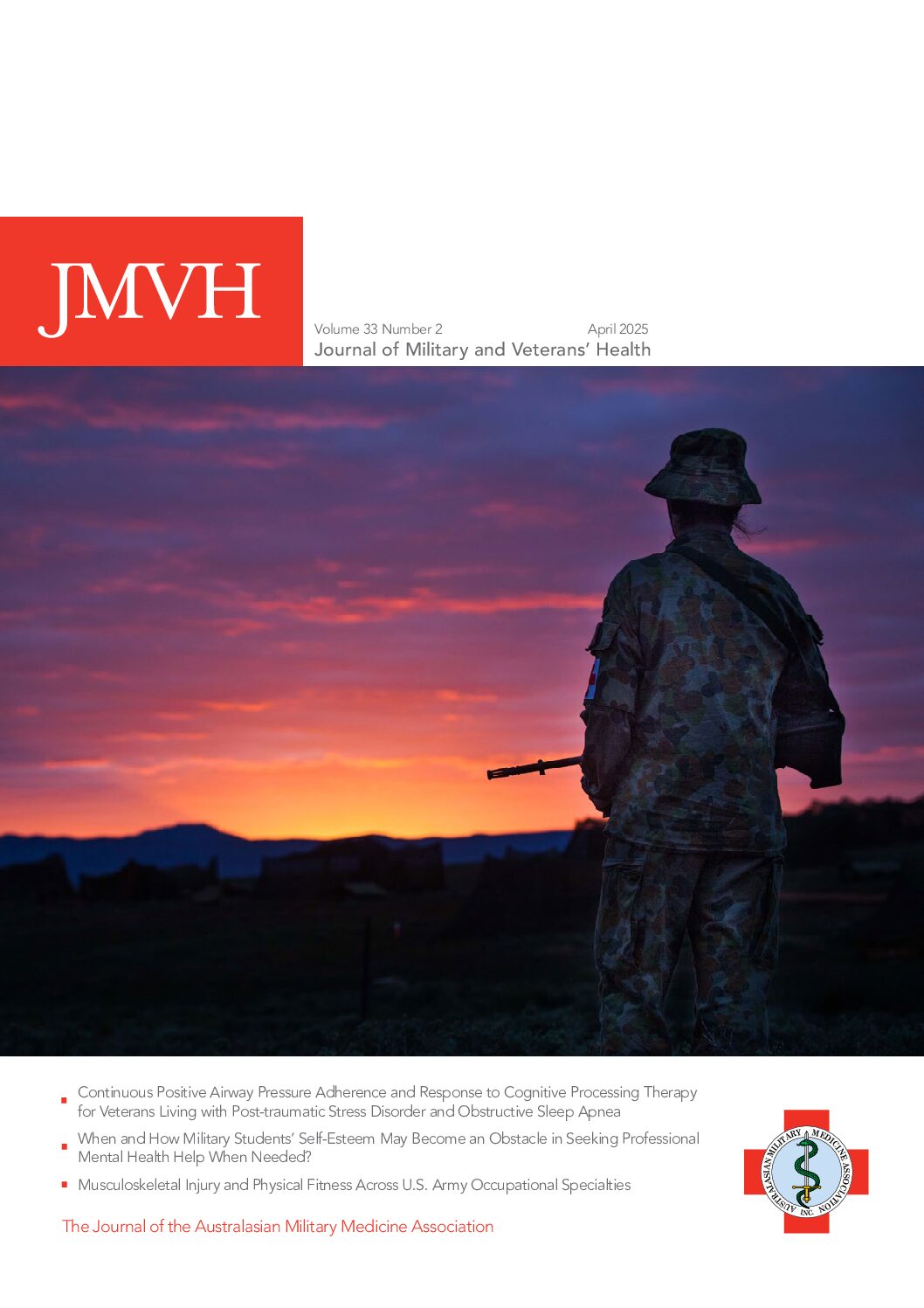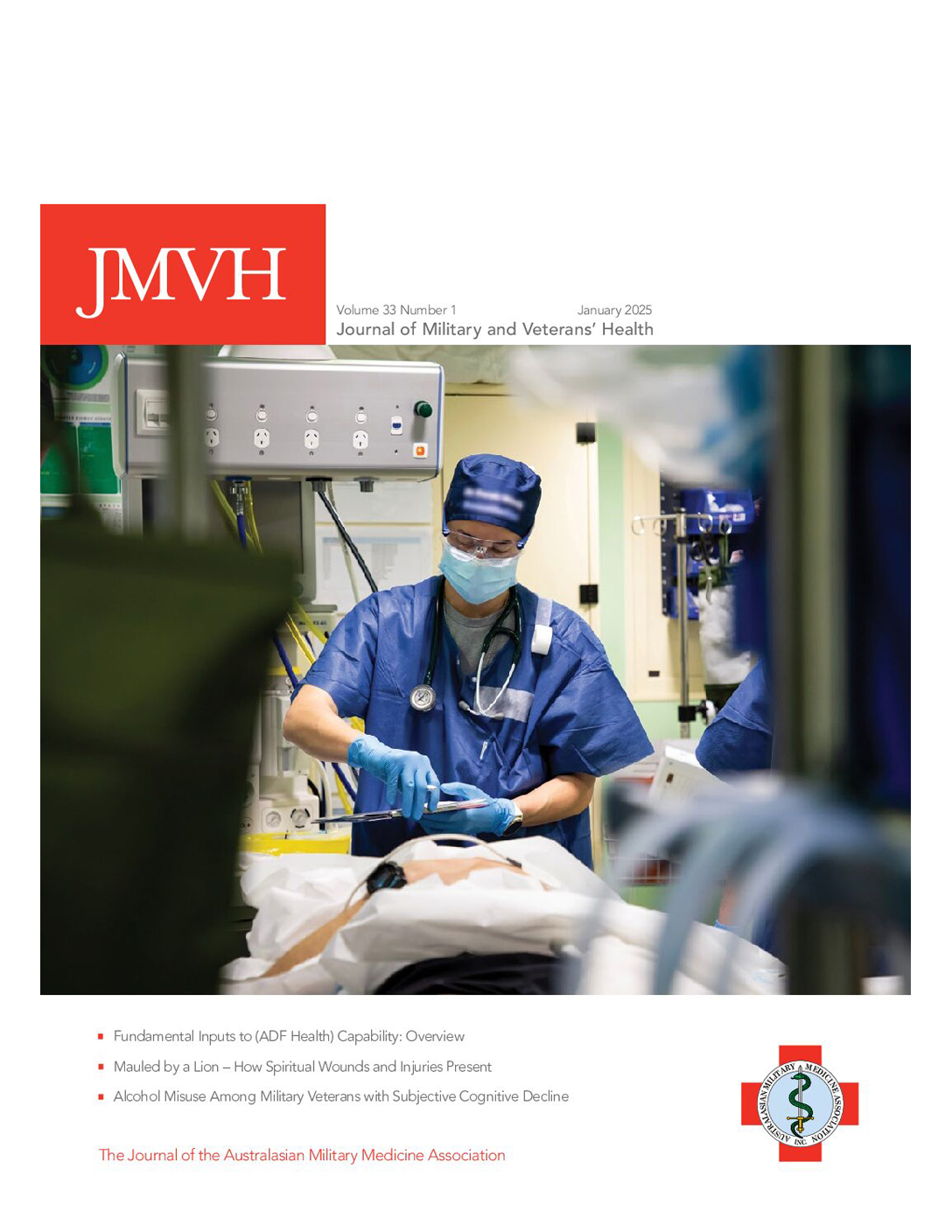Melanoma in Aircrew and Defence Members: A Narrative Literature Review
Abstract Melanoma is the most serious form of skin cancer. While classical risk factors are well described, the literature debates whether specific subgroups in the community have an increased risk of developing the condition. These include those who work as aircrew or in the defence forces. While occupational skin cancer is increasingly recognised, it is… Read more »
Caring for Post-9/11 Veterans in the Civilian Sector: Knowledge and Readiness of Registered and Advance Practice Nurse Providers
Abstract Importance: Since 2001, 3.5 million United States service members deployed overseas in support of the post-9/11 Global War on Terror. While healthy and fit upon deployment, veterans have experienced many complex and often unexplainable illnesses and chronic diseases, with more than 520 000 being diagnosed with cancer. With the implementation of the VA MISSION… Read more »
Incidences and Trends of Cardiovascular Determinants and Diagnoses in Active Duty Service Members
Abstract Obesity, alcohol use and hypertension place military service members at a greater risk of developing cardiovascular disease (CVD). The current study utilised the Defense Medical Epidemiology Database (DMED) data to conduct a retrospective cohort study on the incidence rate trends of CVD and six risk factors (per 10 000) in active duty service members from… Read more »
Hearing Health in the Australian Defence Force
Loud, hazardous noise exposure is ubiquitous and unavoidable in the Defence Force. As a result, it has the unfortunate but foreseeable effect of inducing early-onset hearing loss and/or tinnitus among service members. In Australia, Australian Defence Force (ADF) members and veterans can receive fully subsidised hearing care under the Commonwealth Hearing Services Program (HSP). While… Read more »
Measuring Dental Fear and Anxiety in New Zealand Defence Force Personnel
Abstract Background: The widely-used Dental Anxiety Scale (DAS) has practical and theoretical limitations. The Index of Dental Anxiety and Fear (IDAF-4C) was developed to overcome these shortcomings but requires more psychometric analysis to determine its utility. Purpose: To compare DAS and IDAF-4C validity and reliability among New Zealand Defence Force (NZDF) personnel. Material and methods:… Read more »
Editorial – Deception in War and Peace
DECEPTION IN WAR AND PEACE Deception of an enemy force in conflict dates back millennia. In the lead up to the second Battle of El Alamein in October 1942, Lieutenant General Montgomery initiated a deception plan, Operation Bertram, to mislead the Axis forces on the time, place and direction of any future attacks. This involved… Read more »
Treatment at Point of Injury – A Proposal for an Enhanced Combat First Aider and Health Technician Skillset
Abstract Management of trauma in the future operating environment might be significantly different from the recent experience in the Middle East Region if it were to occur in the context of hostilities between coalition, including Australian forces and a near-peer or peer-level threat. Specifically, reliance on rotary-wing aeromedical evacuation may be compromised if air superiority… Read more »
Permanent Medical Disqualification of Iranian Air Medical Transportation Pilots
Abstract Background: Health is a state of complete physical, mental and social wellbeing. Disability is defined as the effect of a disorder on a person’s physical, mental or social activities. Purpose: Determine the causes and diseases leading to early permanent medical disqualification of Iranian rotary and fixed-wing air medical transportation pilots from 1990 to 2020…. Read more »
Toughening Up: Bullying in the British Army during the First World War
Abstract Hussar Trooper John Flood, Private C. Niblett and Private Jamie Benjafield are three British soldiers who had similar bullying experiences during their service in the British Army. All three men were antagonised by a fellow serviceman, were punished by the institution they served and felt aggrieved at their treatment. The only particular difference between… Read more »
Changing the Way We Treat Tinnitus
Abstract Tinnitus is among the top three most frequently accepted service-related conditions for Australian veterans. Veterans have described the effects of tinnitus as causing physical, emotional and social problems. In addition, many veterans with tinnitus, especially those with troublesome tinnitus, have other health conditions, such as hearing loss, insomnia, anxiety and depression. Research suggests tinnitus… Read more »
English Medieval Ships, Warfare and Medicine
Introduction Previous articles describe the development from prehistory to the end of the Viking period, of a cycle whereby increasing trade necessitated larger and more efficient ships to transport merchandise and better weapons to defend or attack them, both of which facilitated more trading opportunities. However, it was not until the mid-18th century that Western… Read more »
The Impact of Military Combat Uniform on Injury Rate During Basic Military Training in Greek Naval Cadets
Introduction Musculoskeletal injuries are a common occurrence during the period of basic military training (BMT). During the BMT period, it is estimated that 25% of male and 50% of female trainees experience injuries. In a review of Army basic training, injury risk-factor studies showed that increased age, smoking history and prior sedentary lifestyle among male… Read more »
U.S. Blue Water Navy Veterans of the Vietnam War: Comparisons from the Vietnam Era Health Retrospective Observational Study (VE-HEROeS)
Abstract Background: US Vietnam War Blue Water Navy veterans (BWN) conducted military operations on Vietnam’s offshore waters and likely experienced various war-related exposures. The overall health of the BWN has never been systematically studied. Purpose: Describe and compare BWN’s health with other servicemembers and non-veterans of the Vietnam era. Materials and methods: Survey of 45… Read more »
War-Related Dysentery Epidemics in the Australian Army
Dysentery (blood and pus in faeces) has been an epidemic disease in armies throughout history. The Australian Imperial Force (AIF) encountered epidemic dysentery in both Gallipoli in 1915 and Palestine in 1918. During World War II, dysentery epidemics were a military problem in Queensland and Northern Territory. A massive dysentery epidemic involving AIF soldiers, Japanese… Read more »
A comparison of 20mSRT scores and time loss due to injury for the first six months of training at Australian Defence Force Academy from 1999 to 2000
This study investigated the relationship between initial 20 metre shuttle run test (20mSRT) and time loss due to injury. We found an association between low 20mSRT scores, as conducted on arrival at ADFA, and subsequent risk of time loss due to injury, though the sample size studied was small. Fitness, as measured by 20mSRT, may… Read more »
Abstract from the Literature
Jortani SA, Snyder JW, Valdes JR. The role of the clinical laboratory in managing chemical or biological terrorism. CHn Chern 2000 Dec; 46(12): 1883-93. Background: Domestic and international acts of terrorism using chemicals and pathogens as weapons have recently attracted much attention because of several hoaxes and real incidents. Clinical laboratories, especially those affiliated with… Read more »
Abstract from the Literature
Bovard RS. Injuries to avian researchers at Palmer Station, Antarctica from penguins, giant petrels and skuas. Wild Environ Med 2000, 11, 94-98. This paper describes 5 cases of injury to seabird researchers between 1996 and 1999 at Palmer Station, Antarctica. The injuries were inflicted by three seabird species: the Adelie penguin (Pygoscelis adeliae); the southern… Read more »
Australian Military Medicine Association – 9th Annual Conference – Hobart 2000
The Australian Military Medicine Association held its most successful conference ever at the Hotel Grand Chancellor in Hobart from the 20th to 22nd of October 2000. About 120 delegates attended and were privileged to hear some 30 high-quality papers read and join in a number of extra-Conference activities. The conference was opened at Anglesea Barracks… Read more »
AMMA Awards and Grants
For the first year, the Association’s new awards and grants system was implemented. The following awards and grants were announced at the 2000 Conference. Weary Dunlop Award The Weary Dunlop Award, named after our first life member, is awarded to the best original paper presented at the Annual Conference and is worth $500. The Conference… Read more »
Asthma in the military. An evaluation of asthma morbidity and the standard of care at an Australian Defence Force establishment
The 6 RAAF Hospital Morbidity Study (1993-94).1 was designed to document the morbidity of a population of service personnel by analysing the presenting problems of 1,807 consecutive consultations. The study generated some interest in morbidity in the Australian Defence Force (ADF) and it was decided to ascertain the impact of a common medical problem on… Read more »






